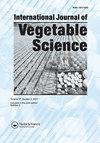形态学、杂交能力和条形码分析表明Benincasa属为单型,Praecitrullus属为独特属
Q2 Agricultural and Biological Sciences
引用次数: 0
摘要
分步分析植物起源中心和分布中心的核心变异性可以解决任何植物物种在分类地位上的冲突。冬瓜[西班牙语]Cogn。和大腹菜(Praecitrullus fistulosus)是世界热带和亚热带地区的蔬菜。贝宁卡萨特有基因型的鉴定导致需要验证该属的单型状态。Tinda,也被称为圆瓜,被推荐作为贝宁卡萨的第二个物种。这项研究检验了贝宁卡萨是单型的假设。对一个包括26个葫芦和5个冬瓜在内的迷你核心标本的形态评价显示出变异性。冬瓜和田瓜基因型在多种形态性状上存在差异。聚类分析对冬瓜和天麻进行了区分,差异接近70%。所有的冬瓜种质在两个方向上都是自由杂交的,排除了任何新种的可能性。天麻与冬瓜的不交性证实了其遗传独特性。从matK和ITS2位点鉴定出9个明显区分属的条形码。由于其独特的形态特征、不可杂交的性质和不同的条形码,本宁卡萨应被认为是单型的,并为Praecitrullus保留了一个单独的属地位。本文章由计算机程序翻译,如有差异,请以英文原文为准。
Morphology, cross ability, and barcode analysis suggest the monotypic status of Benincasa and distinct genus status for Praecitrullus
ABSTRACT Step-wise analysis of core variability in centers of origin and distribution can resolve conflicts over the taxonomic status of any plant species. Ash gourd [Benincasa hispida (Thunb.) Cogn.] and tinda [Praecitrullus fistulosus (Stocks) Pangalo] are vegetables in tropical and subtropical regions of the world. Identification of unique genotypes under Benincasa has led to a situation that requires verifying the monotypic status of this genus. Tinda, also known as round melon, was recommended to be included as a second species in Benincasa. This study tested the hypothesis that Benincasa is monotypic. Morphological evaluation of a mini-core collection comprising 26 ash gourd and 5 tinda entries exhibited variability. Ash gourd and tinda genotypes varied for multiple morphological traits. Cluster analysis differentiated ash gourd and tinda, with nearly 70% dissimilarity. All ash gourd accessions were freely crossable in both directions, ruling out the possibility of any new species. Non-cross-ability of tinda with ash gourd has confirmed its genetic distinctiveness. Nine barcodes distinctly differentiating the genera were identified from the matK and ITS2 loci. With the characteristic morphological traits, non-crossable nature and distinct barcodes that are not shared with any of the members of Praecitrullus, Benincasa should be considered monotypic and a separate genus status retained for Praecitrullus.
求助全文
通过发布文献求助,成功后即可免费获取论文全文。
去求助
来源期刊

International Journal of Vegetable Science
Agricultural and Biological Sciences-Plant Science
CiteScore
3.10
自引率
0.00%
发文量
30
期刊介绍:
The International Journal of Vegetable Science features innovative articles on all aspects of vegetable production, including growth regulation, pest management, sustainable production, harvesting, handling, storage, shipping, and final consumption. Researchers, practitioners, and academics present current findings on new crops and protected culture as well as traditional crops, examine marketing trends in the commercial vegetable industry, and address vital issues of concern to breeders, production managers, and processors working in all continents where vegetables are grown.
 求助内容:
求助内容: 应助结果提醒方式:
应助结果提醒方式:


